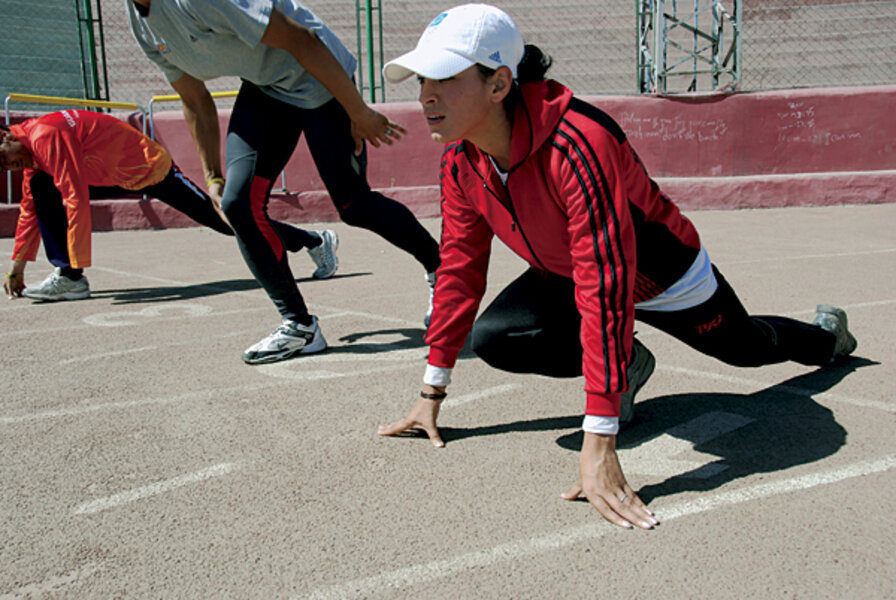Afghan sprinter tries to beat the clock – and pollution
Loading...
| Kabul, Afghanistan
During a warm-up run, what bothers Afghan sprinter Tahmina Kohistani is not the two men standing by the track to leer at her as she jogs ("You must tolerate that if you want to be an athlete here," she says). It is the perpetual smog that hangs over Kabul like a pot lid.
Deaths caused by air pollution in the Afghan capital alone rival the number of civilians killed nationwide every year due to war-related violence. Training outdoors in such heavy pollution, Ms. Kohistani has to worry as much about respiratory problems as her sprint times.
Kohistani has qualified to represent her country in the 100- and 200-meter races at the London Olympics, but she lacks something as fundamental as a training center in a location without lethal levels of air pollution. Her plight is a reminder that not all Olympians are created equally. While many competitors benefit from extensive state-sponsored programs, such as in China, or world-class facilities, such as in America, others train on threadbare tracks or in neglected pools.
The problem is particularly acute in Afghanistan. The war-racked country not only has few athletic facilities; it operates under something of a caste system when it comes to its Olympians.
While most Afghans like sport, they're often hesitant to support their athletes unless they bring home medals. The attitude has created a dilemma. Winners are lavished with lucrative sponsorships and unique training opportunities, but those who fail to fill the nation's trophy rack rarely get the resources needed to improve.
The Afghan Taekwondo team, for instance, has medaled in some international competitions, and now its athletes are training for the Olympics in Korea. Untested athletes like Kohistani are left to work out in Kabul with the aid of local trainers. They struggle to reach international competitive standards: Kohistani's times are comparable to those of high school athletes in the United States.
"When an Afghan athlete goes abroad, the nation expects a victory. They never think about the possibility of a loss," she says. "The athletes must think about the hopes of the Afghan people and try their best, but the nation must also see how we train and compare it to the facilities other people have."
Low-key but determined, Kohistani trains three hours a day, starting at 8 a.m., in Kabul's Ghazi Stadium. During the Taliban regime, the stadium was the scene of numerous public executions. But within the last several years it has undergone renovation, including the addition of an all-weather track. Though the surface already shows signs of wear, those who used to train on the old asphalt track say the improvements have helped them drop their times.
While Kabul's pollution and unwanted spectators prove a challenge for Kohistani, her trainer says that she and Massoud Azizi, the other Afghan track athlete who will compete in London, have about 80 percent of the equipment they need. Still, he complains that the government hasn't provided them with their $20 per day training allowance meant to help them eat healthily and get other resources.
"It discourages the athletes if no one pays attention to you unless you win a medal," says Karim Azizi, the Afghan Olympic track coach.
Kohistani grew up in a family of sports enthusiasts with a particular passion for soccer. It wasn't until middle school that she first learned about track when the school system was establishing an athletic program. Kohistani made the team; and eight years later, the 22-year-old managed to become the Afghan women's national champion in both the 100 and 200 meters.
While she's seen fellow female runners leave the sport in the face of family pressure from relatives who say it is inappropriate for women to be athletes, Kohistani says her family has always supported her. "My family is [politically] moderate, so they never opposed me playing any sports," says the young runner, who wears a hijab when she isn't practicing but during workouts opts for a more practical head covering, such as a baseball cap or bandanna.
Kohistani knows she likely won't be standing on a medal podium in London, but she remains undaunted. "Just attending the Olympics as the only Afghan female track athlete makes me feel like I've already won a medal," she says.
Sunday:
Gladys Tejeda: Getting to the Olympics on borrowed shoes
Monday:
Hiroshi Hoketsu: A Japanese Olympian defies the age barrier
Kayla Harrison: An American Olympian rebuilds a life through judo and friends
Tuesday:
Mohamed Hassan Mohamed: Training for the Olympics in the shadow of war
Behdad Salimi: An Iranian Olympian carries the weight of a nation
Wednesday:
Yamilé Aldama: A British track star jumps through a tough decade
Geeta Phogat: How an Indian wrestler defied gender taboos
Thursday:
Tahmina Kohistani: Afghan sprinter tries to beat the clock - and pollution





